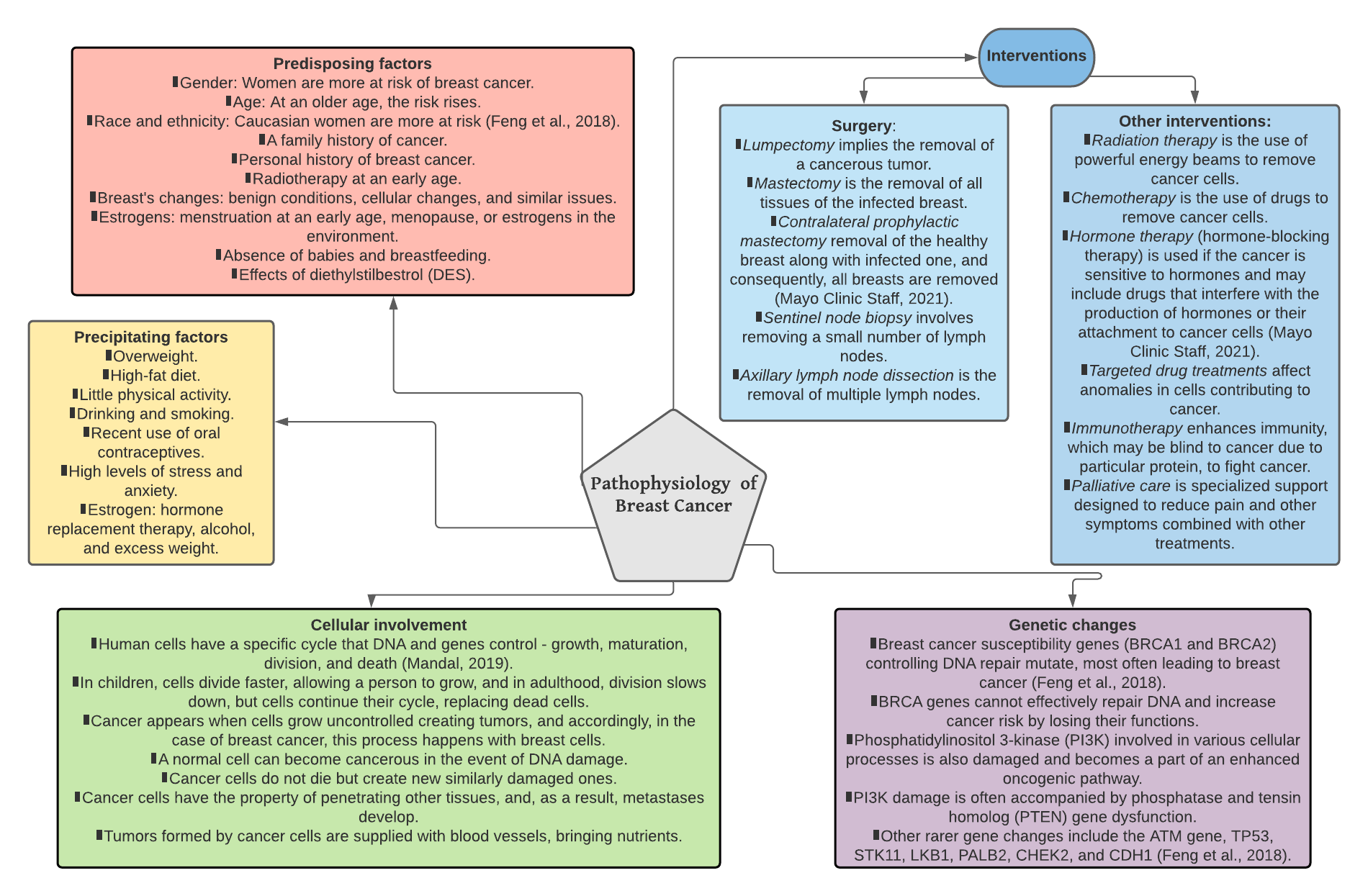Pathophysiology of Breast Cancer: Concept Map

Introduction: Carolyn Cross: Treating Patients With Cancer and Heart Disease
Carolyn Cross
Involving patients in treatment through education is an integral part of recovery. Moreover, education on specific problems and establishing its priorities contribute to preventing many diseases and reducing the burden on hospitals and medical personnel. In the analyzed case, Carolyn Cross is at high risk for breast cancer; she has hypertension, high cholesterol, and is pre-diabetic. Based on the existing problems, the presence of metabolic syndrome can be assumed (Dong et al., 2021). As a result, Carolyn’s educational priorities are:
- Diet training to maintain a healthy weight and pressure at the optimal level, eliminating foods containing a lot of cholesterol and sugar from the diet.
- Physical exercise training of suitable intensity for identified Carolyn’s condition.
- Provide information on required blood pressure, cholesterol, diabetes, and breast cancer screenings.
Technology Usage
Health care providers need to choose the most effective ways to educate patients. The use of technology may be helpful in such a case. In particular, technology makes educational information more accessible. Interactive technologies, in turn, help keep patients’ attention, make information more exciting and memorable. Moreover, modern technologies can provide opportunities for communication between service providers and patients to clarify a patient’s condition. In some cases, technology transmits patient indicators to medical personnel to indicate the need for an appointment. Finally, the technologies can remind patients of the necessary screenings, regular exercises, or medication.
Interdisciplinary Team for Patients with Cancer and Heart Disease
Heart disease and cancer are connected, and this link’s study is essential for more effective treatment and prevention of these diseases. Creating an interdisciplinary team on cancer and heart diseases can contribute to these goals. Such a team may consist of a cardiologist, oncologist, nurses from two departments, a dietitian, and a personal trainer. Each member of the interdisciplinary team involved in treating patients with cancer and heart disease should focus on educational priorities such as:
- Understanding common risk factors for developing and worsening breast cancer and cardiovascular diseases (CVD). Factors include aging, smoking, alcohol, unhealthy diet, family history, overweight, and sedentary lifestyle (Mehta et al., 2018).
- The relationship between CVD and cancer. Heart diseases affect the way cancer is treated and its duration. Cancer, in turn, increases the risk of new CVD or causes complications (Mehta et al., 2018).
- Surveillance, prevention, treatment, and management of cardiotoxicity.
Conclusion
Breast cancer is a severe disease that develops when the body’s cells begin to divide uncontrollably and form tumors. Its treatment involves surgery and other dangerous and complex interventions. Cancer has an interconnection with cardiovascular disease, in particular common risk factors. Patients need to focus on maintaining their health for disease prevention. In particular, diet, exercise, maintaining a healthy weight, and abandoning bad habits are essential. Health care providers can use technology to effectively educate patients on the preventive or treatment measures they need.
References
Dong, S., Wang, Z., Shen, K., & Chen, X. (2021). Metabolic syndrome and breast cancer: Prevalence, treatment response, and prognosis.Frontiers in Oncology, 11. Web.
Feng, Y., Spezia, M., Huang, S., Yuan, C., Zeng, Z., Zhang, L., Ji, X., Liu, W., Huang, B., Luo, W., Liu, B., Lei, Y., Du, S., Vuppalapati, A., Luu, H. H., Haydon, R. C., He, T. C., & Ren, G. (2018). Breast cancer development and progression: Risk factors, cancer stem cells, signaling pathways, genomics, and molecular pathogenesis.Genes & Diseases, 5(2), 77–106. Web.
Mandal, A. (2019). Breast cancer pathophysiology.News-Medical. Net. Web.
Mayo Clinic Staff. (2021). Breast cancer. Mayo Clinic. Web.
Mehta, L. S., Watson, K. E., Barac, A., Beckie, T. M., Bittner, V., Cruz-Flores, S., Dent, S., Kondapalli, L., Ky, B., Okwuosa, T. and Piña, I.L., & Volgman, A. S. (2018). Cardiovascular disease and breast cancer: Where these entities intersect: A scientific statement from the American Heart Association.Circulation, 137(8), e30-e66. Web.